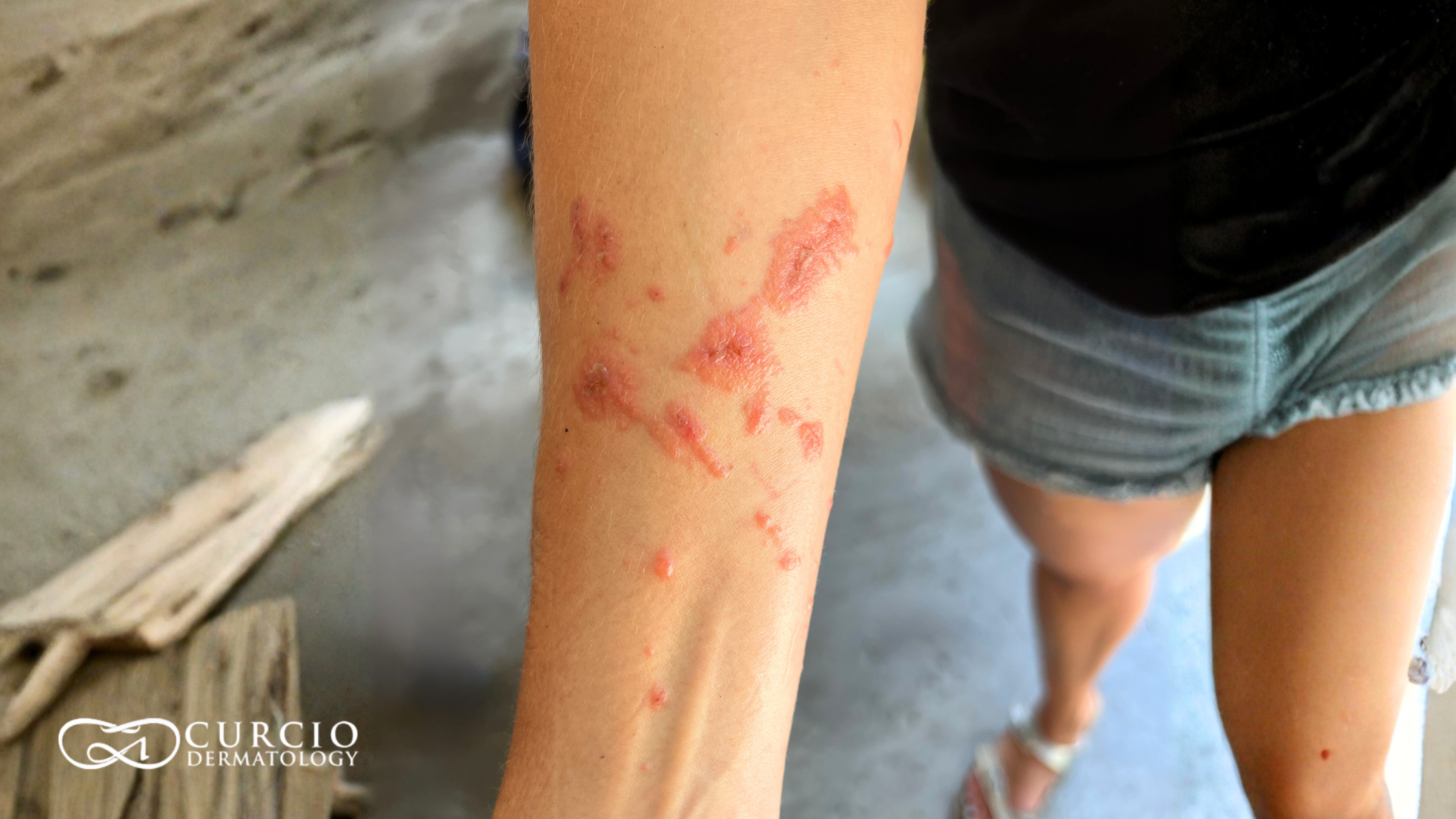Tennessee’s rolling hills, wooded trails, and lush landscapes make it a beautiful place to explore, but they also come with a catch: they are poison oak’s prime territory. Each year, countless Nashville-area residents experience the red, itchy, blistering rash that follows contact with this common plant.
At Curcio Dermatology in Nashville, we see patients throughout spring, summer, and early fall who have developed poison ivy reactions after hiking, gardening, camping, or simply walking their dogs. The reason these reactions are so frequent in Middle Tennessee has a lot to do with one key factor: humidity.
What Causes Poison Ivy / Poison Oak Rash
Poison ivy, along with its close relatives poison oak and poison sumac, produces an oily resin called urushiol. This sticky substance is found on the leaves, stems, and roots of the plants and is responsible for triggering allergic reactions in about 85% of people who come into contact with it.
Even a small amount of urushiol can cause a rash. It easily transfers from plant to skin, clothing, tools, or even pet fur, and it can remain active for weeks if not washed off properly.
When urushiol touches the skin, the body’s immune system mistakes it for a harmful substance, releasing chemicals that cause redness, swelling, and the intense itching associated with poison ivy dermatitis.
Why Tennessee’s Humid Climate Makes It Worse
Tennessee’s warm, humid environment creates the perfect conditions for poison oak to flourish. Here’s why:
- Long Growing Season: The plant thrives from early spring through late fall in Nashville’s moderate-to-hot weather, giving residents months of potential exposure.
- High Humidity: Moisture in the air keeps urushiol potent longer, allowing it to stick to skin and surfaces more easily.
- Dense Vegetation: Poison ivy loves shady, wooded areas — exactly the kind of landscape found in Tennessee’s parks and greenways.
- Sweat and Friction: During outdoor activities, perspiration and movement help spread urushiol on the skin, making rashes more severe and widespread.
The result? More opportunities for contact, stronger reactions, and a higher number of patients visiting dermatologists across the region each year.
Who’s Most at Risk in Middle Tennessee
While anyone can develop a poison ivy rash, some people are at higher risk due to frequent outdoor activity. This includes:
- Hikers and Runners along local trails like Radnor Lake, Percy Warner Park, and Shelby Bottoms Greenway.
- Gardeners and Landscapers working in overgrown yards or wooded areas.
- Children playing outside during warm months.
- Pet Owners — dogs and cats can carry urushiol on their fur, unknowingly transferring it to their owners.
Recognizing and Treating a Poison Ivy / Poison Oak Reaction
Poison ivy symptoms usually appear within 12 to 48 hours of exposure and can last up to three weeks. Common signs include:
- Redness, itching, and swelling
- Blistering or oozing rash
- Streaks or patches where the plant brushed against the skin
If you suspect poison ivy or poison oak exposure, wash the affected area immediately with soap and cool water. Clean under fingernails, and launder any clothing or towels that may have come in contact with the plant.
At-home relief:
- Cool compresses
- Calamine lotion or hydrocortisone cream
- Oral antihistamines for itching
When to see a dermatologist:
- The rash spreads to your face or genitals
- Severe swelling or pain develops
- Signs of infection (pus, fever, increasing redness)
- Over-the-counter remedies aren’t working after a few days
At Curcio Dermatology, we offer expert evaluation and treatment for poison ivy reactions, including prescription-strength corticosteroids, medicated creams, and guidance on how to prevent recurrence. Our dermatologists can also identify secondary infections or allergic complications that require medical attention.
Preventing Poison Ivy / Poison Oak Exposure in Tennessee
Prevention is always easier than treatment. Here are some dermatologist-approved tips to stay rash-free:
- Learn to Identify It: “Leaves of three, let it be.” Look for clusters of three pointed leaves, sometimes with red stems or shiny surfaces.
- Dress Smart: Wear long sleeves, pants, gloves, and closed-toe shoes when working or hiking outdoors.
- Wash Up Promptly: Shower as soon as possible after outdoor activity, and wash clothes separately.
- Clean Your Gear and Pets: Urushiol can linger on tools, shoes, and pet fur — wipe them down after being outside.
- Use Barrier Creams: Products containing bentoquatam can help block urushiol from reaching your skin.
Stay Safe, Stay Rash-Free
Poison oak is an unfortunate part of Tennessee’s natural beauty, but with awareness and prevention, you can enjoy the outdoors without discomfort. If you find yourself dealing with a stubborn or painful rash, Curcio Dermatology in Nashville is here to help.
Our experienced dermatologists provide expert care for poison ivy and other skin conditions, helping you heal quickly and safely.
Contact Curcio Dermatology today to schedule an appointment or learn more about treatment options for poison ivy and allergic skin reactions.








